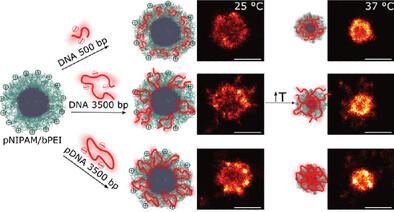Our official English website, www.x-mol.net, welcomes your
feedback! (Note: you will need to create a separate account there.)
Polymer Nano‐Carrier‐Mediated Gene Delivery: Visualizing and Quantifying DNA Encapsulation Using dSTORM
Small ( IF 13.0 ) Pub Date : 2024-11-18 , DOI: 10.1002/smll.202405929 Xhorxhina Shaulli, Aura Maria Moreno‐Echeverri, Mariza Andoni, Eileen Waeber, Shivaprakash N. Ramakrishna, Cornelia Fritsch, Dimitri Vanhecke, Barbara Rothen‐Rutishauser, Frank Scheffold
Small ( IF 13.0 ) Pub Date : 2024-11-18 , DOI: 10.1002/smll.202405929 Xhorxhina Shaulli, Aura Maria Moreno‐Echeverri, Mariza Andoni, Eileen Waeber, Shivaprakash N. Ramakrishna, Cornelia Fritsch, Dimitri Vanhecke, Barbara Rothen‐Rutishauser, Frank Scheffold

|
The success of gene therapy hinges on the effective encapsulation, protection, and compression of genes. These processes deliver therapeutic genes into designated cells for genetic repair, cellular behavior modification, or therapeutic effect induction. However, quantifying the encapsulation efficiency of small molecules of interest like DNA or RNA into delivery carriers remains challenging. This work shows how super‐resolution microscopy, specifically direct stochastic optical reconstruction microscopy (dSTORM), can be employed to visualize and measure the quantity of DNA entering a single carrier. Utilizing pNIPAM/bPEI microgels as model nano‐carriers to form polyplexes, DNA entry into the carrier is revealed across different charge ratios at temperatures below and above the volume phase transition of the microgel core. The encapsulation efficiency also depends on DNA length and shape. This work demonstrates the uptake of the carrier entity by primary derived macro‐phages and showcases the cell viability of the polyplexes. The study shows that dSTORM is a potent tool for fine‐tuning and creating polyplex microgel carrier systems with precise size, shape, and loading capacity at the individual particle level. This advancement shall contribute significantly to optimizing gene delivery systems.
中文翻译:

聚合物纳米载体介导的基因递送:使用 dSTORM 可视化和定量 DNA 封装
基因治疗的成功取决于基因的有效封装、保护和压缩。这些过程将治疗基因输送到指定的细胞中,以进行基因修复、细胞行为改变或治疗效果诱导。然而,量化目标小分子(如 DNA 或 RNA)到递送载体中的包封效率仍然具有挑战性。这项工作展示了如何采用超分辨率显微镜,特别是直接随机光学重建显微镜 (dSTORM) 来可视化和测量进入单个载体的 DNA 数量。利用 pNIPAM/bPEI 微凝胶作为模型纳米载体形成多链体,在低于和高于微凝胶核心体积相变的温度下,DNA 以不同的电荷比进入载体。包封效率还取决于 DNA 长度和形状。这项工作证明了原代衍生的巨噬细胞对载体实体的摄取,并展示了多链体的细胞活力。研究表明,dSTORM 是一种有效的工具,可用于微调和创建在单个颗粒水平上具有精确尺寸、形状和负载能力的多重微凝胶载体系统。这一进步将为优化基因递送系统做出重大贡献。
更新日期:2024-11-18
中文翻译:

聚合物纳米载体介导的基因递送:使用 dSTORM 可视化和定量 DNA 封装
基因治疗的成功取决于基因的有效封装、保护和压缩。这些过程将治疗基因输送到指定的细胞中,以进行基因修复、细胞行为改变或治疗效果诱导。然而,量化目标小分子(如 DNA 或 RNA)到递送载体中的包封效率仍然具有挑战性。这项工作展示了如何采用超分辨率显微镜,特别是直接随机光学重建显微镜 (dSTORM) 来可视化和测量进入单个载体的 DNA 数量。利用 pNIPAM/bPEI 微凝胶作为模型纳米载体形成多链体,在低于和高于微凝胶核心体积相变的温度下,DNA 以不同的电荷比进入载体。包封效率还取决于 DNA 长度和形状。这项工作证明了原代衍生的巨噬细胞对载体实体的摄取,并展示了多链体的细胞活力。研究表明,dSTORM 是一种有效的工具,可用于微调和创建在单个颗粒水平上具有精确尺寸、形状和负载能力的多重微凝胶载体系统。这一进步将为优化基因递送系统做出重大贡献。


















































 京公网安备 11010802027423号
京公网安备 11010802027423号